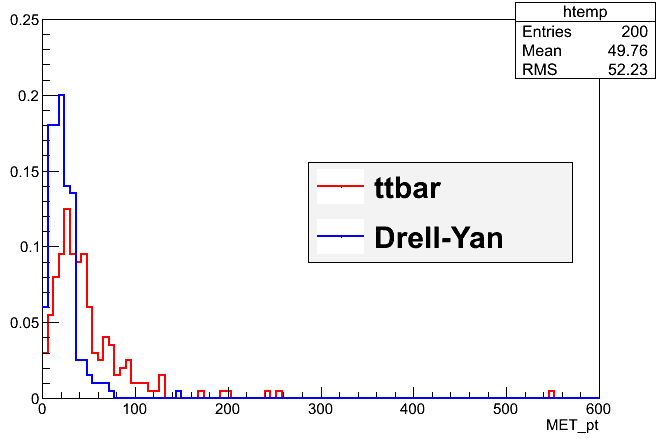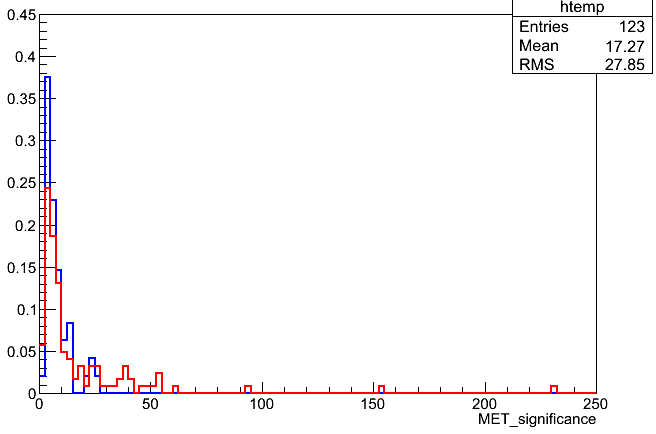Basic objects hands-on
Overview
Teaching: 0 min
Exercises: 40 minQuestions
How can I navigate the physics object references to compute identification criteria?
How can I separate events with and without invisible particles?
Objectives
Practice expanding identification criteria beyond POET defaults.
Practice interacting with ROOT file output from POET.
Choose your exercise! The first several exercises all relate to manipulating identification criteria for muons, taus, or jets. Please complete one of them.
Exercise 1 option A: add alternate muon IDs and isolation corrections
Using the documentation on the TWiki page:
- adjust the 0.4-cone muon isolation calculation to apply the “DeltaBeta” pileup correction.
- add the pass/fail information about the Loose identification working point.
- try to recreate the Tight identification working point from detector information criteria!
Solution:
The DeltaBeta correction for pileup involves subtracting off half of the pileup contribution that can be accessed from the “iso04” object already being used:
if (itmuon->isPFMuon() && itmuon->isPFIsolationValid()) { auto iso04 = itmuon->pfIsolationR04(); muon_pfreliso04all.push_back((iso04.sumChargedHadronPt + iso04.sumNeutralHadronEt + iso04.sumPhotonEt - 0.5*iso04.sumPUPt)/itmuon->pt());To add new variables we need to check four code locations: declarations, branches, vector clearing, and vector filling. You might add Loose ID beneath the existing Tight and Soft IDs in each section:
std::vector<float> muon_softid; std::vector<float> muon_looseid;mtree->Branch("muon_softid",&muon_softid); mtree->GetBranch("muon_softid")->SetTitle("soft cut-based ID"); mtree->Branch("muon_looseid",&muon_looseid); mtree->GetBranch("muon_looseid")->SetTitle("loose cut-based ID");muon_softid.clear(); muon_looseid.clear();muon_softid.push_back(muon::isSoftMuon(*itmuon, *vertices->begin())); muon_looseid.push_back(muon::isLooseMuon(*itmuon));The TWiki also gives the member functions needed to reconstruct the muon ID. We can see from the built-in tightID method that a vertex is needed for some of the criteria:
muon::isTightMuon(*it, *vertices->begin()). To learn more about the vertex collection you can refer toVertexAnalyzer.cc.std::vector<bool> muon_isTightByHand; if( it->isGlobalMuon() && it->isPFMuon() && it->globalTrack()->normalizedChi2() < 10. && it->globalTrack()->hitPattern().numberOfValidMuonHits() > 0 && it->numberOfMatchedStations() > 1 && fabs(it->muonBestTrack()->dxy(vertices->begin()->position())) < 0.2 && fabs(it->muonBestTrack()->dz(vertex->position())) < 0.5 && it->innerTrack()->hitPattern().numberOfValidPixelHits() > 0 && it->innerTrack()->hitPattern().trackerLayersWithMeasurement() > 5) { muon_isTightByHand.push_back(true); }
Exercise 1 option B: add alternate tau IDs
Many other tau discriminants exist. Based on information from the TWiki, save the values for some discriminants that are based on multivariate analysis techniques.
Solution:
The TWiki describes Loose/Medium/Tight ID levels for a “IsolationMVA” and “IsolationMVA2” algorithms. They can be accessed like the other tau IDs, but you might need to refer to the output of
edmDumpEventContentto find the exact form of the InputTag name.Add declarations:
std::vector<bool> tau_idisoMVA2loose; std::vector<bool> tau_idisoMVA2tight;Add branches:
mtree->Branch("tau_idisoMVA2loose",&tau_idisoMVA2loose); mtree->GetBranch("tau_idisoMVA2loose")->SetTitle("tau id loose isolation from MVA2"); // ...etc for other ID...Create handles and get the information from the input file:
Handle<PFTauCollection> taus; iEvent.getByLabel(InputTag("hpsPFTauProducer"), taus); Handle<PFTauDiscriminator> tausLooseIso, tausVLooseIso, tausMediumIso, tausTightIso, tausDecayMode, tausRawIso, tausTightEleRej, tausTightMuonRej, tausLooseIsoMVA2, tausTightIsoMVA2; // new things only iEvent.getByLabel(InputTag("hpsPFTauDiscriminationByLooseIsolationMVA2"),tausLooseIsoMVA2); iEvent.getByLabel(InputTag("hpsPFTauDiscriminationByTightIsolationMVA2"),tausTightIsoMVA2);Clear the vectors at the beginning of each event:
tau_idisoMVA2loose.clear() tau_idisoMVA2tight.clear()And finally, access the discriminator from the second element of the pair:
tau_idisoMVA2loose.push_back(tausLooseIsoMVA2->operator[](idx).second); tau_idisoMVA2tight.push_back(tausTightIsoMVA2->operator[](idx).second);
Exercise 1 option C: apply noise jet ID
Use the cms-sw github repository to learn the methods available for pat::Jets (hint: the header file is included from
PatJetAnalyzer.cc). Implement the jet ID and reject jets that do not pass. Rejection means that information about these jets will not be stored in any of the tree branches.Solution
The header file we need is for particle-flow jets:
interface/Jet.hfrom the link given. It shows many functions like this:/// chargedHadronEnergyFraction (relative to uncorrected jet energy) float chargedHadronEnergyFraction() const {return chargedHadronEnergy()/((jecSetsAvailable() ? jecFactor(0) : 1.)*energy());}These functions give the energy from a certain type of particle flow candidate as a fraction of the jet’s total energy. We can apply the conditions given to reject jets from noise at the same time we apply a momentum threshold:
for (std::vector<pat::Jet>::const_iterator itjet=myjets->begin(); itjet!=myjets->end(); ++itjet){ if (itjet->chargedHadronEnergyFraction() > 0 && itjet->neutralHadronEnergyFraction() < 1.0 && itjet->electronEnergyFraction() < 1.0 && itjet->photonEnergyFraction() < 1.0){ // calculate things on jets } }
Exercise 2: real and fake MET
Compile all your changes to POET so far and run 400 events from two different simulation samples. One test file contains top quark pair events, so some events will have leptonic decays that include neutrinos and some events will not. The other test file contains Drell-Yan events without neutrinos. Review TTree::Draw from the pre-exercises – can you draw histograms of MET versus MET significance and infer which events have leptonic decays?
$ scram b $ # edit python/poet_cfg.py to run over 400 events from the ttbar simulation test file. $ cmsRun python/poet_cfg.py $ # edit python/poet_cfg.py to use this input file: root://eospublic.cern.ch//eos/opendata/cms/MonteCarlo2012/Summer12_DR53X/DYJetsToLL_M-50_TuneZ2Star_8TeV-madgraph-tarball/AODSIM/PU_RD1_START53_V7N-v1/20000/003063B7-4CCF-E211-9FED-003048D46124.root, and to save a file called myoutput_DY.root $ cmsRun python/poet_cfg.py $ root -l myoutput.root [0] TTree *ttbar = (TTree*)_file0->Get("mymets/Events"); [1] TFile *_file1 = TFile::Open("myoutput_DY.root"); [2] TTree *dy = (TTree*)_file1->Get("mymets/Events"); [3] ttbar->Draw("...a branch name...", "...any cuts go here...", "norm") [4] dy->Draw("...a branch name...", "...any cuts go here...", "norm pe same")Solution
The difference between the Drell-Yan events with primarily fake MET and the top pair events with primarily genuine MET can be seen by drawing
MET_ptor by drawingMET_significance. In both distributions the Drell-Yan events have smaller values than the top pair events.

Key Points
All physics objects have multiple identification and isolation schemes.
POET implements the most common identification and isolation criteria used in analyses.
MET exists in all events, but significant differences can be seen between samples with and without real MET.
